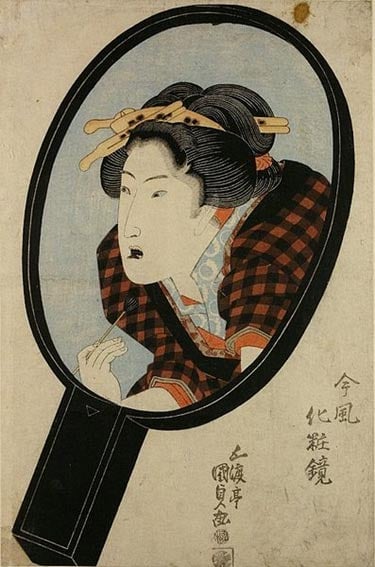The Heian period lasted from 794 to 1185 AD and is known as the end of "classical" Japanese history. This period was named after the city Heian-kyo, the capital at the time, which was later renamed Kyoto.[18] It is during the Heian period that the influences of Buddhism, Taoism and other Chinese styles were most prominent.
Esoteric Buddhism and Mandalas
Tibetan Monks creating a mandala [19]
|
Exclusive sects of Buddhism which were common during this period were Tendai and Shingon Buddhism. They are both known by their elaborate and formal rituals.[18] Among their striking collection of calligraphy, poetry, sculptures and paintings, one symbol made famous during this time was mandalas. Mandalas are circular spiritual symbols still used in rituals today that represent the universe. They are most known for their intricate geometric designs and were used by Buddhist priests to aid in meditation. Mandalas are made by layering colored sand using a special tool that only dispenses a few grains of sand at a time. Most mandalas take weeks to complete and after they finish and pray, the priests will wipe it away as symbolism of impermanence.[19]
Literature and Paintings
Katakana Characters [20]
|
While Chinese was the official written language of the period, the introduction of kana promoted a height in literature and poetry. Kana are the Japanese scripts used in Japan's writing system. They include hiragana, katakana and kanji. Hiragana is a cursive-like alphabet used for the standard Japanese language. Katakana is a similar alphabet to hiragana but it is used for "foreign" words.[20] Kanji is the Chinese characters assimilated into the Japanese written language, however Japanese kanji and Chinese characters (hanzi) do not always correlate to the same meaning or sound.
Hiragana Characters [20]
|
Poetry grew as literacy became more common and was a marker of status. It was expected that nobles in court life were experienced at writing poetry to maintain their reputation. It was believed that the quality of a person's calligraphy was reflective of their soul, and poorly written characters were considered low class. The modern national anthem of Japan, Kimigayo, was written during this time, as well as many well-known works such as Iroha whose author's unknown.[21]
Beauty
Blackened Teeth [22]
|
The Heian period empathized beauty which was considered indicative of a person's character. It was often considered a requirement to take part in the beauty standards of the time,[22] including ohaguro(dying teeth black), powdered faces, goatees, red painted lips and the process of plucking one's eyebrows and redrawing them higher on the head.
References:
[18] The Editors of Encyclopædia Britannica (2010) ‘Heian period | Japanese history’, in Encyclopædia Britannica. Available at: https://www.britannica.com/event/Heian-period (Accessed: 23 February 2017).
[19] Exotic India (2004) The Buddhist Mandala - sacred geometry and art. Available at: http://www.kheper.net/topics/Buddhism/mandala.html (Accessed: 23 February 2017).
[20] The Editors of Encyclopædia Britannica (2016) ‘Kana | Japanese writing’, in Encyclopædia Britannica. Available at: https://www.britannica.com/topic/kana (Accessed: 23 February 2017).
[21] Asia for Educators, (2009) Literature of the Heian period: 794-1185. Available at: http://afe.easia.columbia.edu/special/japan_600ce_heian.htm (Accessed: 23 February 2017).
[22] Szczepanski, K. (2016) Beauty in Heian Japan, 794 - 1185 CE Japanese court ladies’ hair and makeup. Available at: http://asianhistory.about.com/od/japan/a/HeianBeauty.htm (Accessed: 23 February 2017).




